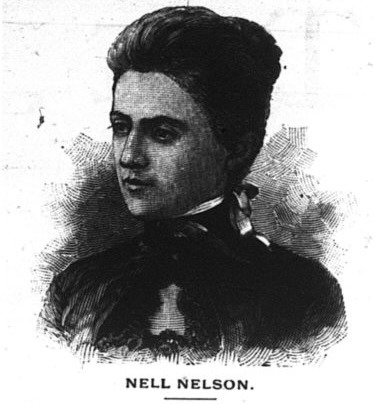Why I chose to write my new book as a graphic novel, a guest post by Nora Neus

I can still remember the exact moment I discovered Nell Nelson. It was in 2017, in the heady early days of the first Trump administration when I was working for Anderson Cooper at CNN. Sitting at my desk in the New York newsroom, I had a few minutes to kill before one of the infamous White House press briefings was set to begin. I’d been researching female journalists a lot in those days, looking for inspiration at a time when the press was under unprecedented attack.
I already knew the story of Nellie Bly, a young woman in the 1880s who faked insanity to be committed to New York’s Blackwell Island asylum to report on the deplorable conditions there for the mentally ill, but I’d stumbled on an article about other so-called “Stunt Girls” who reported undercover in this era. I scrolled down and it was the vintage illustration that caught my eye more than any of the words. The black and white drawing depicted a group of proper-looking Victorian era women with the caption: Guess which one of the above is the ‘girl reporter’? It was impossible—they all looked exactly the same. And that was the point.
SCROLL TO KEEP READING THIS POST

When I scrolled down, another illustration stood out, of one woman in particular: Nell Nelson. She stared at the reader with a kind of calm defiance. Who was she? I wondered. As I read her articles, I was in awe not only of her brave reporting undercover in garment factories to expose dangerous labor practices, but also of her writing itself. Her dispatches were funny, un-self-conscious, stirring, emotional, and overall read like they could have been someone’s diary today not back in the summer of 1888!
Fast forward to years later, when I decided to tell the story of Nell Nelson, and contemporary photojournalist Alice Austen, as a YA historical fiction romance and adventure story, there was no question in my mind what format it would take: a graphic novel!
The story of the stunt girls was made for a graphic novel format. These real-life young women were literally illustrated heroes of their own stories in the pages of the major newspapers of the day, in an era when that wasn’t common or even possible in almost any other medium.
“Stunt reporters put a new female character in the headlines,” writes author Kim Todd in her adult nonfiction book, Sensational: The Hidden History of America’s “Girl Stunt Reporters.” “Not a victim of assault or murder— but a protagonist. Bravery was their brand. It was like they stepped out of the adventure tales that flew off the bookstore shelves, except they were real.”
And it was those illustrated images of the reporters—not the subjects of the story, but the reporters, that specifically made them so popular.
While the articles “had a serious purpose, what lingered in some readers’ minds were the half-page illustrations of the reporter at work, hair billowing, eyes ablaze,” Todd writes. “These lodged the character of the ‘daring journalist’ in the public imagination and set the stage for comic-book female reporters like Lois Lane and Brenda Starr.’”
It wasn’t a coincidence that these same newspapers also had just started to print comics for the first time, popularizing the form that gave rise to graphic novels. The illustrations of the stunt girls that captured my own attention journalists were like real life superheroes.
But even though it was clear to me that this story was begging to be told as a graphic novel, I had my hesitations. And they were entirely rooted in prejudice against the form.
I was not a huge graphic novel reader as a kid. That fact surprises people coming from me, a graphic novel author. But I had fully internalized the messages from teachers and adults around me that graphic novels weren’t “real books,” and somehow didn’t “count.” I took my reading reputation very seriously and wanted to read grown-up books, difficult books, books that would earn an impressed eyebrow raise from our librarian at the check-out desk. I loved the Archie comics I would tear through on the weekends or during the summer, but I didn’t think that “counted” as reading. So, I never chose graphic novels from the library.
It wasn’t just me, either. I’ve since done research into the rise of the format (what can I say, I really do love research!). Writer Joseph Witek wrote in his 1989 book Comic Books as History that there were questions of what merits there could possibly be to graphic novels, which were “traditionally considered juvenile trash literature.” The author writes that “a general reading audience now exists in the United States for narratives written in a medium which has historically been considered solely the domain of subliterate adolescent fantasies and of the crassest commercial exploitation of rote generic formulas.” How surprising!
It wasn’t until I was an adult that I started reading graphic novels myself, first those written for adults and then catching up on those I’d missed written for younger readers. Now I absolutely love pouring through richly illustrated graphic novels, losing myself in the stories as if I were watching them play out on a screen.
Far from silly, childish stories, graphic novels have a long tradition of actually handling very intense and serious topics. Scholar Elaine Martin points out in her academic article about the evolution of the graphic novel that visual storytelling has long used the “subversive power of pictorial satire,” like with broadsheets in the 1700s. “Often they treat serious topics or are aimed at an adult audience and present a socio-political critique.”

Or, put another way by former war reporter and graphic novelist David Axe in what is probably my favorite quote about the genre, “Comics lull you into a false sense of security. You think, this will be funny or at least unserious. Then we hit you with the explosions and the dismemberment. That contrast lends a sharpening effect to the awfulness and violence.”
I hope Renegade Girls similarly surprises readers. What looks like a cute, illustrated graphic novel about two girls falling in love in bright, vivid color, is also a deep narrative about unfair labor practices, the place of women in society and work, and the power of queer love.
SCROLL TO KEEP READING THIS POST
The stories of Nell Nelson and Alice Austen were meant to be told, and I believe meant to be told in nothing other than a graphic novel. I’m so proud to have written this “real book.”
Meet the author

Nora Neus is an Emmy Award–nominated journalist and writer who has reported from inside wartime Ukraine during the Russian invasion, from behind bars at a maximum security prison, from 14,000 feet above sea level in the San Juan Mountains, and from rural Puerto Rico after devastating earthquakes. Nora studied the history of journalism, with a focus on the turn of the twentieth century, for her master’s degree from King’s College London. She invites you to visit her online at noraneus.com.
Instagram: @noraneus
About Renegade Girls: A Queer Tale of Romance and Rabble-Rousing written by Nora Neus with ilustrations by Julie Robine
A swoonworthy queer romance set against a riveting story of social change in the 1880s, this historical graphic novel reimagines the life of America’s first stunt girl—a young undercover reporter—and her whirlwind summer of romance and fighting injustice.
Seventeen-year-old Helena “Nell” Cusack came to New York this summer looking for a story—a real story. She dreams of one day writing hard-hitting articles for the New York Chronicle, but so far she’s only managed to land a job as a lowly society reporter. That is, until Alice Austen strolls into her life, an audacious street photographer who encourages Nell to shake up polite society…and maybe also take a chance on love.
When her best friend, Lucia, is injured while working in a garment factory, Nell is determined to crack the story wide open. Posing as a seamstress, she reports on the conditions from the inside, making a name for herself as theChronicle’s first ever stunt girl. But as Nell’s reporting gains momentum, so do the objections of those who oppose her. Will Nell continue to seek justice—even if it hurts her in the end?
Based on real-life stunt girl Nell Nelson and photographer Alice Austen, this tenderly drawn narrative is about bringing buried stories to light and the bravery of first love.
ISBN-13: 9780316439831
Publisher: Little, Brown Books for Young Readers
Publication date: 04/01/2025
Age Range: 12 – 18 Years
Filed under: Guest Post






